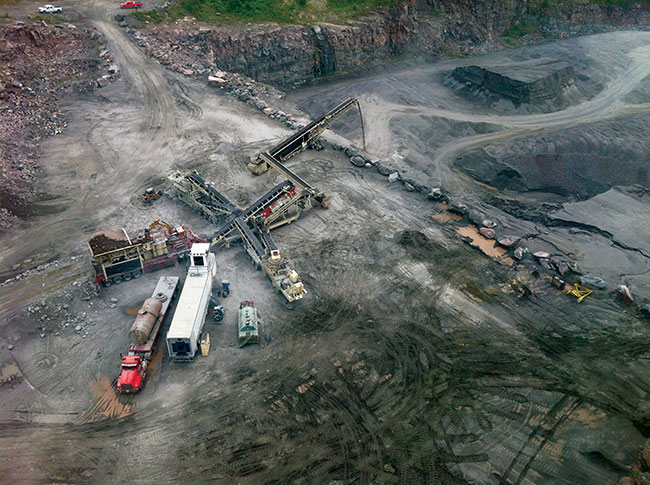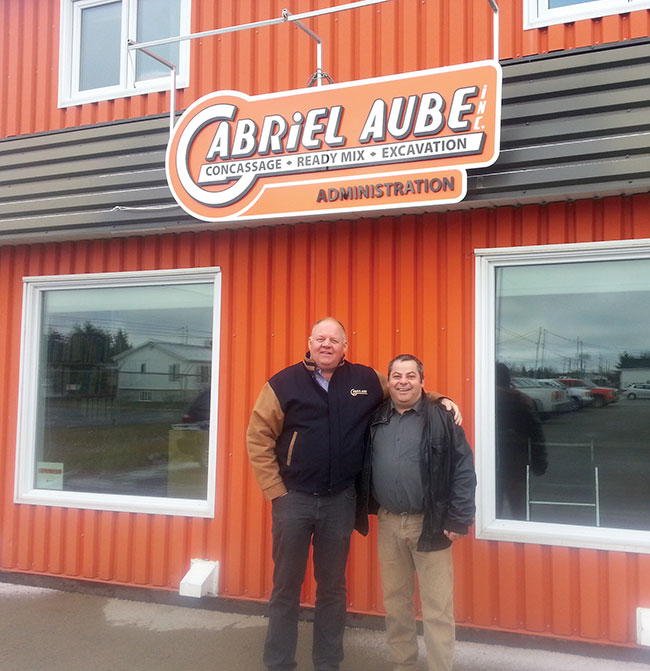
Features
Aggregates
Profiles
Smarter Screening
Mobile contractor maximizes efficiency with synthetic screen media
May 22, 2015 By Carol Wasson
Work smarter, not harder, is a welcome concept in the mobile crushing and screening industry where operations face ever-changing locations, applications and product specifications.
Work smarter, not harder, is a welcome concept in the mobile crushing and screening industry where operations face ever-changing locations, applications and product specifications. Site-to-site moves require a skilled and dedicated labor force for efficient transports, setups, tear-downs and day-to-day operation. Portable spreads must be reliable, highly versatile and easy to maintain. Production goals require maximum uptime.
 |
|
Successful mobile contractors continually seek methods to maximize overall efficiencies. The latter is undoubtedly the case for Gabriel Aubé, Inc., a long-established mobile contractor that offers specialized crushing and screening services throughout northwest Quebec to northeast Ontario. Founded in the 1950s, the company is based in La Sarre, Quebec. It operates two portable processing spreads for contract crushing and screening; and also owns a dozen quarries in different locations on the western Abitibi territory. Owner Jacques Aubé leads the organization as its president. One of his latest processing upgrades includes the conversion to synthetic rubber screen media as an alternative to conventional wire cloth. He describes the result as “smarter screening” with the top benefits being increased wearlife; improved gradations; a reduction in screen panel inventory requirements; and the elimination of the frequent downtime associated with wire cloth changeouts.
Media specification and product support
As to processing upgrades, Aubé says that specifying the right equipment is important; however, having the benefit of ongoing product support before, during and after the installation is even more important to his operation. Aubé chose to work with Polydeck Screen Corporation.
“I was impressed with Polydeck’s thorough introduction and overview of synthetic media, as we had only used wire cloth in the past and we were skeptical about making the switch. They also took a very detailed look at our processes and gradation requirements to ensure proper media specification,” he says, adding that he worked closely with Polydeck regional manager Vito Maraventano, as well as Patrick Seguin, the sales representative for Sling-Choker, a Polydeck regional distributor. “At first I was concerned about aligning with one company, but now I see it as an advantage to have one source. I am grateful for Polydeck’s support. They help us improve what we do,” Aubé says.
Smarter scalping
The media conversion started with the highest impact area, an 8-ft. x 20-ft. triple-deck scalping screen where the top deck was retrofitted with Polydeck’s new Armadex™ rubber screen sections. The middle and bottom decks were fitted with Rubberdex modular screen panels.
Armadex rubber screening media uses Binary Injection Molding (BIM) technology – a proprietary Polydeck manufacturing method that produces 10 times the pressure normally used to produce compression moulded rubber. “Combining this process with premium natural gum rubber and HS/LA steel plate backing produces unprecedented strength in a media product that will deliver far longer wear life at lower costs per ton,” Polydeck regional manager Maraventano says. He adds that the binary injection moulding process also allows customization options that are not available in traditional bolt-down screen media. “The scalping screen is the true workhorse of screens. Typically, opening requirements on the top deck of the scalping screen do not change. As a result, some of our customers have installed Armadex and gotten as much as twice the wear life of their existing media. This is highly advantageous in a scalping application,” Maraventano says.
With the scalping screen fully converted and operational within the Aubé mobile spread, it was initially decided that they would run the screen for several months to gauge the media’s performance before upgrading additional machines. However, it was only a matter of days before Aubé would consider retrofitting the balance of his screens with modular synthetic media.
Smarter solutions
Looking at the effectiveness of conversions to synthetic media is best illustrated by a simple timeline of the initial upgrade within the Aubé plant. The very first conversion (at the scalping screen) became operational at the beginning of the 2013 season. After the 2014 season, the original Armadex panels are still in operation. “Synthetic media is more expensive than wire cloth; however, the wearlife of synthetic media is the payback. The elimination of the downtime to change out wire cloth screens is such a savings for us,” Aubé says.
 |
|
| Jacques Aubé (left) with Patrick Seguin, sales representative with Sling-Choker.changes and 16 road crossings.
|
The modularity of the Rubberdex panels, Aubé says, has also delivered a number of benefits. “We no longer require the labour to change out an entire wire cloth screen. That alone would take several hours, and now we use those hours to process stone,” he says, adding that now it only takes one person to change out panels, or switch panels around, rather than an entire crew to maneuver one large wire cloth screen.
Importantly, Aubé says that he can significantly reduce his inventory requirements with the use of modular synthetic media. “We can use synthetic media panels in any type or any size of vibrating screen, whereas the wire cloth has a specific width and has to be used in a specific size of machine. That requires a lot of wire cloth inventory,” he says.
Maintaining consistent product quality is another top driving factor. Due to the specification of modular panels with varying opening sizes, it is easy for the Aubé crew to change out panels to improve gradations; to meet varying product and specification requirements; and to adjust to multiple material feed types – anything from alluvial, to limestone and granite, as they move from one site to another. Depending upon customer demand, the Aubé plants may relocate anywhere from 10 to more than 20 times per season. “If we have any questions or support needs as we change from one application to another, Polydeck is always accessible to us,” Aubé says.
Working smarter
In the middle of the 2013 season, Aubé converted a 6-ft. x 20-ft. triple-deck; and an 8-ft. x 20-ft. double-deck screen, each with Rubberdex synthetic media. In the fall of 2014, a 5-ft. x 20-ft. triple-deck was converted, with more conversions planned to be operational by the 2015 season. Enough panels are supplied to cover all gradations.
For mobile and stationary plants alike, conversion to synthetic media is ever gaining ground. Versus age-old screening methods, synthetic screening technologies are allowing producers and contractors to consistently work smarter – not harder.
Print this page